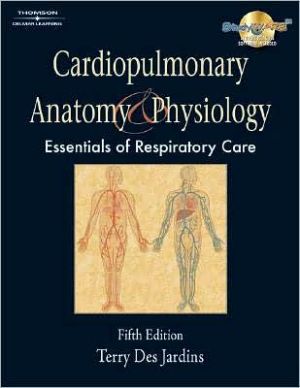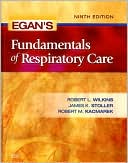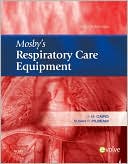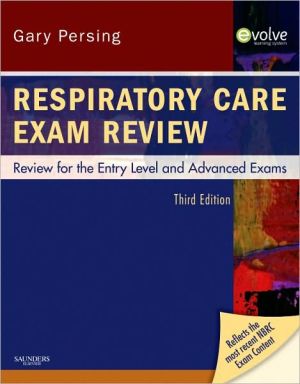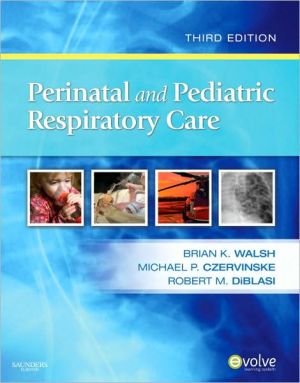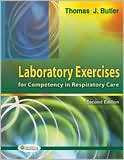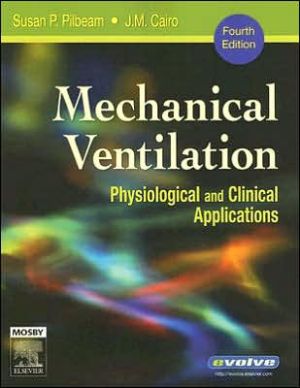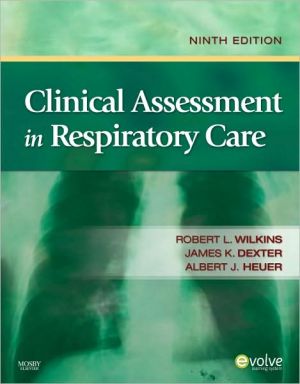Cardiopulmonary Anatomy & Physiology: Essentials for Respiratory Care
This innovative, best-selling book provides the most complete and accurate information about the structure and function of the respiratory system. The relevance to respiratory care practice clearly sets this resource apart, with clinical scenarios to challenge your application of principles and formulas as well as numerous illustrations of common pathological conditions such as cystic fibrosis, chronic bronchitis, and asthma.
Search in google:
This innovative, best-selling book provides the most complete and accurate information about the structure and function of the respiratory system. The relevance to respiratory care practice clearly sets this resource apart, with clinical scenarios to challenge your application of principles and formulas as well as numerous illustrations of common pathological conditions such as cystic fibrosis, chronic bronchitis, and asthma. Doody Review Services Reviewer:Steven K. Hamick, BIS, RCP, RRT, AE-C(William Beaumont Hospitals)Description:This concise yet comprehensive book details the structure and function of the cardiopulmonary system. It updates the fourth edition published in 2002.Purpose:It is designed to provide students of cardiopulmonary anatomy and physiology with accurate and complete information essential for respiratory care. Given the speed of technological changes and their impact on both the educational and professional practice arenas, the author has met his objectives of providing a concise, accurate textbook.Audience:Although written primarily for students in respiratory care programs, students in other disciplines who require in-depth study of the cardiopulmonary system will find this a worthy textbook as well. The author is a respected expert in his field.Features:The book is organized into three sections -- the cardiopulmonary system, advanced cardiopulmonary concepts and related areas, and the cardiopulmonary system during unusual environmental conditions. Each section begins with a list of chapters and each chapter begins with a list of objectives. The text is easy to read and understand and new terms appear in brown bold font. Tables appear throughout each chapter to further clarify the information and colorful illustrations are found on nearly every page. Each chapter ends with a summary and review questions. In addition, most chapters also include clinical application cases. The book ends with a glossary of terms, eight appendixes, bibliography, and an index. Also included is a StudyWARE CD-ROM with quizzes, case study presentations, labeling exercises, and a few games to reinforce learning. Assessment:This is an outstanding and highly recommended textbook. The concise, easy to read format will be welcomed by students. With over 60 updates from the previous edition, respiratory care practitioners will find this a worthy resource as well. University, college, and hospital libraries should have this book in their reference sections.
SECTION I: THE CARDIOPULMONARY SYSTEM. The Anatomy and Physiology of the Respiratory System. Ventilation. The Diffusion of Pulmonary Gases. Pulmonary Function Measurements. The Anatomy and Physiology of the Circulatory System. Oxygen Transport. Carbon Dioxide Transport and Acid-Base Balance. Ventilation-Perfusion Relationships. Control of Ventilation. Fetal Development and the Cardiopulmonary System. Aging and The Cardiopulmonary System. SECTION II: ADVANCED CARDIOPULMONARY ESSENTIALS. Electrophysiology of the Heart and Its Application to Electrocardiography (ECG). ECG Recording, Wave Forms, and Measurements. Common Cardiac Arrhythmias. Hemodynamic Monitoring. Renal Failure and Its Effects on the Cardiopulmonary System. SECTION III: THE CARDIOPULMONARY SYSTEM DURING UNUSUAL ENVIRONMENTAL CONDITIONS. Sleep Physiology and its relation to the Cardiopulmonary System Exercise and Its Effects on the Cardiopulmonary System. High Altitude and Its Effects on the Cardiopulmonary System. High-Pressure Environmentals and Their Effects on the Cardiopulmonary System. APPENDICES I: Symbols and Abbreviations Commonly Used in Respiratory Physiology. APPENDICES II: Units of Measurement. APPENDICES III: Poiseuille's Law. APPENDICES IV: Dubois Body Surface Chart. APPENDICES V: Cardiopulmonary Profile. APPENDICES VI: PCO2/HCO3-/pH Nomogram. APPENDICES VII: Answers to Self-Assessment Questions.
\ Reviewer: Steven K. Hamick, BIS, RCP, RRT, AE-C(William Beaumont Hospitals)\ Description: This concise yet comprehensive book details the structure and function of the cardiopulmonary system. It updates the fourth edition published in 2002.\ Purpose: It is designed to provide students of cardiopulmonary anatomy and physiology with accurate and complete information essential for respiratory care. Given the speed of technological changes and their impact on both the educational and professional practice arenas, the author has met his objectives of providing a concise, accurate textbook.\ Audience: Although written primarily for students in respiratory care programs, students in other disciplines who require in-depth study of the cardiopulmonary system will find this a worthy textbook as well. The author is a respected expert in his field.\ Features: The book is organized into three sections — the cardiopulmonary system, advanced cardiopulmonary concepts and related areas, and the cardiopulmonary system during unusual environmental conditions. Each section begins with a list of chapters and each chapter begins with a list of objectives. The text is easy to read and understand and new terms appear in brown bold font. Tables appear throughout each chapter to further clarify the information and colorful illustrations are found on nearly every page. Each chapter ends with a summary and review questions. In addition, most chapters also include clinical application cases. The book ends with a glossary of terms, eight appendixes, bibliography, and an index. Also included is a StudyWARE CD-ROM with quizzes, case study presentations, labeling exercises, and a few games to reinforce learning. \ Assessment: This is an outstanding and highly recommended textbook. The concise, easy to read format will be welcomed by students. With over 60 updates from the previous edition, respiratory care practitioners will find this a worthy resource as well. University, college, and hospital libraries should have this book in their reference sections.\ \
